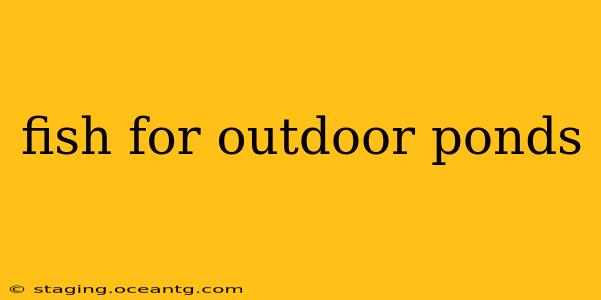Creating a thriving outdoor pond ecosystem is a rewarding experience, and choosing the right fish is a crucial step. This guide will help you select fish that are well-suited to your pond's size, environment, and your personal preferences. We'll cover everything from common pond fish to considerations for maintaining a healthy and balanced pond.
What are the best fish for outdoor ponds?
The best fish for your outdoor pond depend heavily on several factors: the pond's size, its depth, the amount of sunlight it receives, and the existing plant life. Smaller ponds require smaller, less demanding fish, while larger ponds can support a wider variety and larger numbers of fish. Some popular choices include:
-
Koi: Known for their vibrant colors and relatively large size, Koi are a stunning addition to larger ponds. However, they require significant space, good water quality, and a deeper pond to thrive. They also need a substantial filtration system.
-
Goldfish (Common and Fancy): Goldfish are a classic and hardy choice, suitable for a range of pond sizes. Common goldfish are more adaptable and robust than their fancy counterparts, which often require more specialized care.
-
Shubunkin: A type of goldfish, Shubunkins are known for their calico-patterned scales and are quite hardy. They are a good option for ponds with moderate sunlight and plant life.
-
Ornamental Pond Fish: Many other species, such as grass carp (for weed control – use cautiously!), and various types of minnows, can add diversity and beauty to your pond. Researching the specific needs of any less common species is crucial before introducing them.
What size pond do I need for different types of fish?
Pond size directly impacts the number and type of fish you can keep. As a general rule:
-
Small Ponds (<500 gallons): Limit yourself to a small number of smaller fish, like a few goldfish or small minnows. Overstocking can quickly lead to poor water quality.
-
Medium Ponds (500-1500 gallons): You have more flexibility here, potentially keeping a few larger goldfish, or a smaller number of Koi.
-
Large Ponds (>1500 gallons): Larger ponds can support a greater variety and number of fish, including multiple Koi, several goldfish, and other ornamental species.
What plants are good for a pond with fish?
Pond plants are essential for a healthy ecosystem. They provide oxygen, shade, and shelter for your fish, as well as help to filter the water. Excellent choices include:
-
Oxygenating plants: These plants, like Elodea and Hornwort, provide vital oxygen to the water.
-
Marginal plants: These plants grow along the edges of the pond, providing cover and habitat. Examples include Irises and Water Lilies.
-
Floating plants: Duckweed and Water Hyacinth help to shade the water, reducing algae growth.
How many fish can I put in my pond?
Overstocking is a common mistake that leads to poor water quality, fish stress, and ultimately, fish death. A good rule of thumb is to allow approximately 1 inch of fish per gallon of water. However, this is just a guideline, and you should adjust based on the size and type of fish. Larger, more active fish require more space than smaller, less active ones.
What kind of filtration do I need for my pond?
Filtration is critical for maintaining healthy water quality. The type and size of filter you need depend on the size of your pond and the number of fish. Consider:
-
Biological filtration: This is crucial for breaking down waste products.
-
Mechanical filtration: This removes debris and solids from the water.
-
UV sterilization: A UV sterilizer can help control algae growth.
How deep should my pond be for fish?
The necessary depth varies by fish species. Koi, for example, need a deeper pond for winter survival in colder climates. A general guideline is that your pond should be at least 3 feet deep to provide adequate shelter and prevent freezing in winter.
By carefully considering these factors and researching the specific needs of your chosen fish species, you can create a thriving and beautiful outdoor pond that brings you years of enjoyment. Remember that responsible pond ownership involves regular maintenance and monitoring of water quality.
